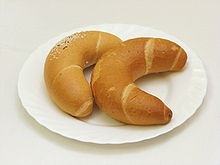Kipferl

Two kiflis, the left one is salted
|
|
| Course | Dessert |
|---|---|
| Place of origin | Austria, Hungary, Serbia |
| Region or state | Balkan, Central Europe |
| Serving temperature | Baked |
| Main ingredients | Wheat flour |
Kifli (Hungarian pronunciation: [ˈkifli], meaning "twist", "crescent") is a traditional European yeast roll made into a crescent shape. The pastry is called kifli in Hungarian, rohlík in Czech, Kipferl in Austrian German, кифла/kifla in Serbian, kifla in Bosnian, corn in Romanian, рогалик/rogalik in Russian, рогалик/rohalyk in Ukrainian, кифла in Bulgarian, кифла in Macedonian, rožok in Slovak and rogal in Polish. In Danish and Swedish, it is called giffel.
Kifli are made by cutting sheets of soft yeast dough into triangular wedges then rolling them into crescent shapes which are then baked. Kifli differs from the French croissant (again meaning "crescent") in that it is made from a plain, bread-like dough (thus being more akin to a roll than to pastry) and being both thinner and longer. They may also come in different sizes, some of them equalling in weight a small bread loaf.
When they come out of the oven, the rolls can be left plain or given a water brushing to make them shiny, or can be given an egg wash and sprinkled with either poppy seeds or caraway fruits mixed with coarse salt. The latter variety is often made into a straight shape, instead of curved like a crescent. Kifli is eaten like bread or rolls, usually made into a sandwich, sometimes plain or with butter like a fresh baguette. Often, especially for breakfast, the topping is jam or honey, or they may be used for dunking.
...
Wikipedia
